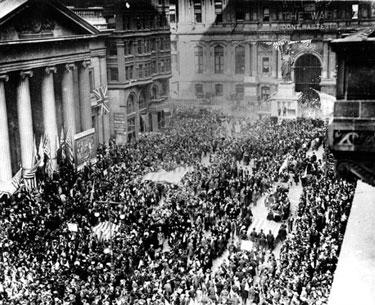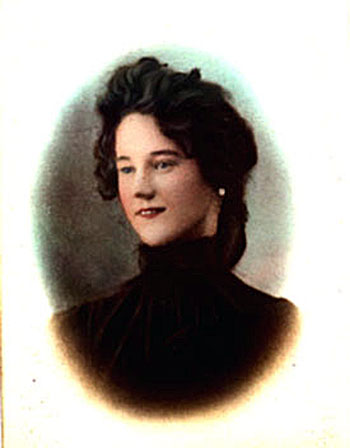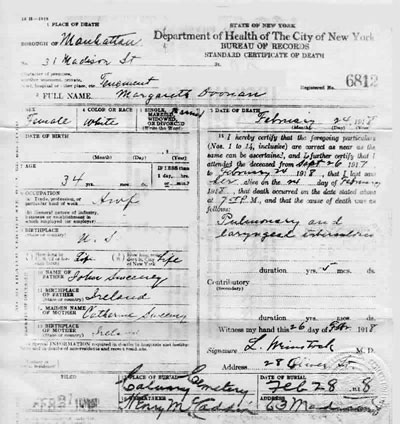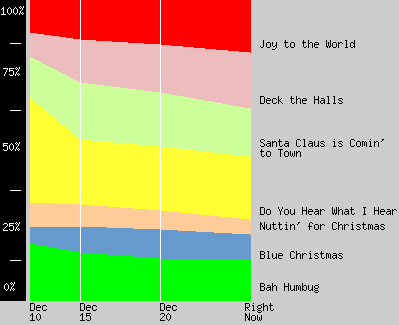 |
|
Come Next Year We All Will Be Together ...
By most standards, Christmas 1918 would have been a perfect locus for the merriest of Yuletides. A true time for peace on earth, good will towards men if ever there was going to be one. Not just Christmas but the end of the "Great War" (before we'd learned to number them) had come at last, an armistice signed just one month before.
Many of the boys would be home in time for the holidays. Regrettably the planet was also in the grasp of an influenza pandemic. The "Spanish flu," one of the deadliest pandemics in human history, raged worldwide between 1918 and 1919, even more so than the war itself. And more deadly than any war, it was poised to smother the holiday season. An estimated 500 million people caught the Spanish Flu—about one-third of the world’s population. It killed more people than the Black Plague did in the 14th century. Somewhere between 17 million and 50 million (possibly even 100 million) souls would succumb, including some 675,000 Americans. One of those souls was my maternal grandmother. The 1918 pandemic actually caused average life expectancy in the United States to drop by about 12 years for both men and women. It was an H1N1 virus, avian in origin, but no one is sure where it came from. It wasn't Spain, its name notwithstanding. It showed up first in Europe, the United States and parts of Asia but very swiftly spread around the globe. It was called the Spanish flu because Spain, which had remained neutral in World War I, was the first country to publicly report cases. China, France and the United States already had cases, but wartime censorship largely kept their outbreaks out of the news. The first official U.S. case was recorded in early March 1918, at a U.S. Army training camp in Kansas. After a mess cook complained of flu-like symptoms in the morning, another 107 soldiers followed by lunchtime. Five weeks later, more than 1,000 soldiers had been infected and 47 were dead. Doctors had no effective remedies for this virus. There were no vaccines or antivirals. (The first licensed flu vaccine wouldn't appear until the 1940s.) The only ways for controlling the spread were non-pharmaceutical interventions: isolation, quarantine, personal hygiene, disinfectants, limits on public gatherings. The science behind these was very young and applied inconsistently. Basically communities imposed quarantines, ordered citizens to wear masks and shut down public places. Local health departments shuttered schools, playhouses, dance halls, movie theaters and other gathering places. Even churches. Libraries quit lending books. People were encouraged to avoid shaking hands and to stay indoors. Regulations were passed banning spitting in public. The first wave of the pandemic, starting in the spring of 1918, was generally mild. Those infected suffered typical flu symptoms like chills, fever and fatigue but generally got better after a few days, The number of reported deaths was low. As Christmas approached, medical officials began to feel confident that the death rate might even be slowing.Things seemed to be improving enough to loosen some pandemic restrictions, establishing more permissible hours for business operations and relaxing bans on attending church services. Just in time for the holidays. And regrettably premature. At its worst, an ill-timed capitulation to wishful thinking. Things were getting worse, not better. Church attendance swelled, with grateful worshipers thankful for release from their isolation and eager to join in congregational observance of their winter holiday traditions. Social activities, parties and holiday gatherings surged. 
Temple University Libraries, Special Collections Research Center
As news of the World War I armistice reached Philadelphia, huge crowds formed spontaneously throughout the city, this one in South Penn Square in front of the city's Liberty Statue at City Hall.
It wasn't just Christmas spirit. The war's end gave vent to spontaneous national rejoicing. Crowds had taken to the streets to kiss, hug and celebrate. Then, the returning doughboys unwittingly contributed to the deadly cocktail that was brewing. Somewhere in Europe, a mutated strain of the flu virus had emerged with the power to kill its victims within 24 hours of the first signs of infection. The second wave was rolling through the nation, far more deadly and highly contagious, just as impatience was replacing optimism and a tired populace began discarding the things that had been keeping it safe.  The Spanish flu spread in three different waves, starting in March 1918 and subsiding by summer of 1919. It actually peaked in the U.S. during its second wave, in the fall of 1918. This wave was responsible for most of the U.S. deaths attributed to the pandemic. A lack of understanding of how the disease was spread, skepticism of authority and public health pronouncements and just plain pent up frustration and false hope against tedium all contributed to a lessening of national will. In the state of Washington, of roughly 5,000 residents who died from the flu in the 1918-19 period, half died from January 1919 forward. At the tail end of September 1918 the city of Philadelphia organized a Liberty Loan Drive parade to support the war effort and encourage the purchase of war bonds. Some 200,000 people jammed Broad Street, cheering a line of marchers that stretched for two miles. A raucous day was finished off with a concert led by John Philip Sousa. Within 72 hours, every bed in the city's 31 hospitals was filled. Within two weeks 2,600 Philadelphians had died from the flu or its complications. A week later, the figure rose to more than 4,500. |

Not even the president was spared. In April 1919, shortly after arriving for the World War I peace negotiations in Paris, Woodrow Wilson became seriously ill with influenza-like symptoms. The White House claimed he had merely caught a cold from the rainy weather in Paris.  Margaret Sweeney, 1884-1918. Died at age 34, when the oldest of her four children (my mother) had just turned 13. But a closer reading of her death certificate, obtained years ago from the New York City Department of Health, reveals the cause of death was not influenza after all but pulmonary and laryngeal tuberculosis. And in February 1918, a bit early for the Spanish flu in New York. All these years, had it wrong.
 A third wave began in January 1919, in Australia where it killed 12,000 following the lifting of a maritime quarantine. It then spread once more to Europe and the United States, where it lingered until June 1919. In Spain, Serbia, Mexico and Great Britain, it killed hundreds of thousands. The third wave was less severe than the second but also more deadly than the first wave. In the United States, isolated outbreaks occurred in Los Angeles, New York, Memphis, Nashville, San Francisco and St. Louis. Overall, American mortality counts were in the tens of thousands during the first six months of 1919. In summer of 1919, the flu pandemic came to an end for all intents and purposes. By 1920, it was still a threat, but by then fewer people really were dying from it. Scientists say that viruses often (not always) become less lethal over time. It’s in the best interest of the virus to spread before killing the host. In 2008, researchers announced they’d discovered what had made the 1918 flu so deadly: a group of three genes enabled the virus to weaken a victim’s bronchial tubes and lungs and clear the way for bacterial pneumonia. It's also part of the natural order of things for influenza viruses to change and to mutate in the direction of other influenza viruses and in that process become milder. And in that sense, The Spanish flu virus is still with us. The Washington Post recently reported that in 2009, David Morens and Jeffery Taubenberger, two influenza experts at the National Institutes of Health, co-authored an article with Anthony S. Fauci explaining how the descendants of the 1918 influenza virus have contributed to a "pandemic era" that has lasted these past hundred years. At the time the article was published, an H1N1 influenza virus in public circulation was a fourth-generation descendant of the then novel virus from 1918. Since 1918, there have also been several other influenza pandemics, although none as deadly. A flu pandemic from 1957 to 1958 killed around two million people worldwide, including some 70,000 in the United States, and a pandemic from 1968 to 1969 killed approximately one million people, including some 34,000 Americans. The Spanish Flu and the Coronavirus are not at all the same. Which is why the word "novel" is now frequently attached to the latter. But there are similarities worth noting. Both came from winged animals (birds and bats respectively). Both are respiratory viruses. Both spread so rapidly that they overwhelmed medical infrastructures with their high transmissibility and resistance to known treatments. Both created huge economic and social dislocations, and with both viruses our country’s leaders exacerbated the problem by ignoring early warning signs and then being slow, and even unwilling, to react even after they caught on. And both really screwed up Christmas. A teachable moment for next time, if ever there was going to be one. |
|||||||||
|
||||||||||
Go to websitesammy.com homepage
